The kuhli loach is a charming and popular freshwater fish belonging to the Cobitidae family. Known for its peaceful demeanor, this elongated, snake-like fish is particularly active during the evening and night, making it a delightful addition to any community aquarium. While kuhli loaches are relatively easy to care for, their nocturnal habits and natural wariness may pose challenges for aquarists who wish to observe their activities during the day. However, with the right environment and tank mates, they can thrive and provide unique interaction in the aquarium.
In this guide, you will discover essential information on how to keep and feed kuhli loaches, as well as tips for breeding them and selecting appropriate tank mates. Whether you are a beginner or an experienced aquarist, understanding these aspects will enhance your experience with this fascinating species.
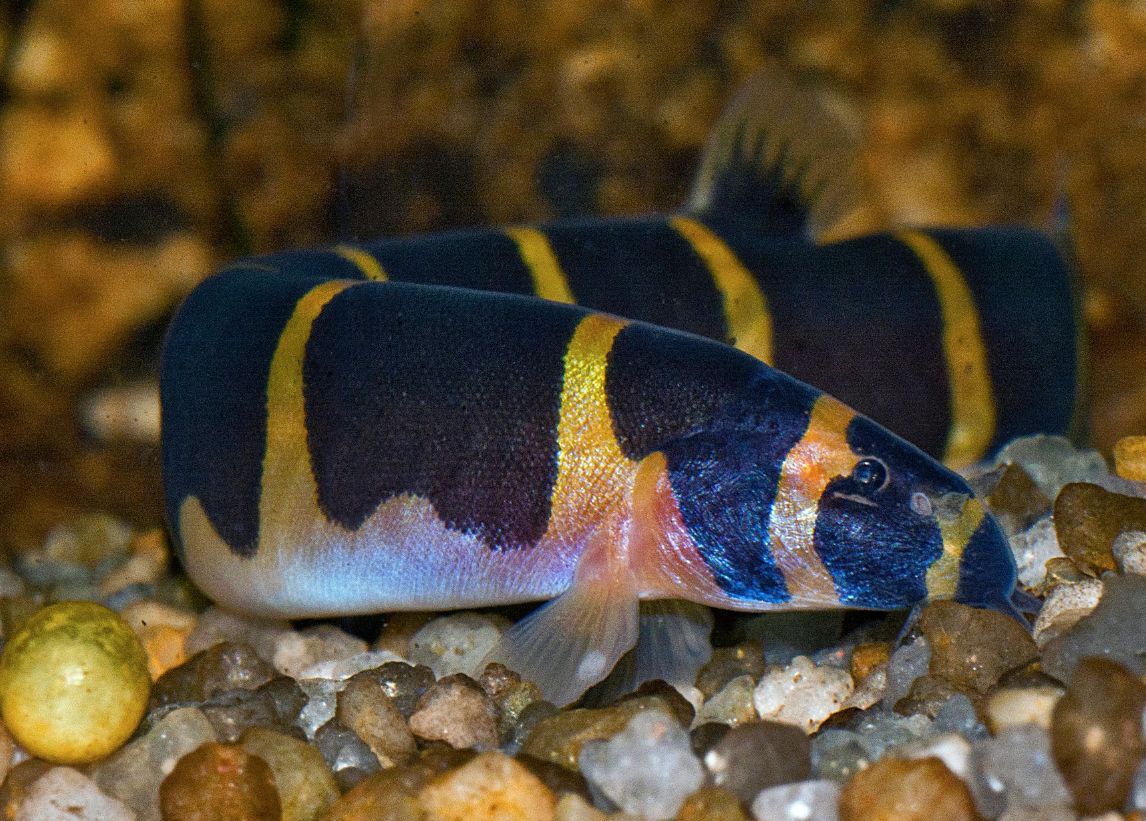
Contents
Habitat in the wild
The kuhli loach is a fascinating freshwater fish belonging to the genus Pangio within the Cobitidae family. This species, previously known as Acanthophthalmus kuhlii, was named by the French ichthyologist Achille Valenciennes in honor of German zoologist Heinrich Kuhl. Found primarily in Southeast Asia, kuhli loaches thrive in slow-moving streams and rivers across regions like India, Sumatra, Singapore, Malaysia, Java, and Borneo.
In their natural habitat, kuhli loaches prefer areas with soft, muddy bottoms and ample cover, including driftwood, rocks, and submerged roots. These structures provide essential hiding spots, allowing them to feel secure. Being nocturnal, they are most active at night, foraging for food among sandy or muddy substrates adorned with leaf litter and plant debris. While they are often found in small groups, kuhli loaches are not schooling fish, enjoying the company of others without the need for constant social interaction. Understanding their habitat preferences is crucial for aquarists looking to create a thriving environment for these unique and captivating fish.
Description
The kuhli loach boasts a striking appearance, characterized by a pink-yellow body adorned with 12 to 17 wide dark stripes. These stripes help them blend in with their natural habitat and provide camouflage from potential predators. The color bands are more prominent on the sides of the fish and may appear fainter or broken towards the belly. This color pattern helps them to mimic the dappled light and shadow found in the dimly lit environments they inhabit in the wild.
Three pairs of whisker-like barbels on its head aid in foraging, enhancing its sensory perception. The dorsal fin is positioned closely to the anal fin, creating a streamlined silhouette that aids in its agile movements.
A fascinating aspect of the kuhli loach is its ability for intestinal respiration, a trait shared with other members of the loach family. By swallowing air bubbles, they can oxygenate their blood in specific areas of their intestinal tract, allowing them to survive in low-oxygen environments typical of their natural habitat. Additionally, kuhli loaches are known as “weather forecasting fish” due to their sensitivity to changes in atmospheric pressure. When such shifts occur, they may display frantic swimming patterns, darting along the tank walls or in circles.
Size
Kuhli loaches are small fish, typically growing to about 8 to 12 cm (3 to 5 inches) in length. In a home aquarium, they usually don’t exceed 8 cm (around 3 inches). However, it’s important to remember that individual fish can vary in size, with some potentially being slightly larger or smaller than the average.
Lifespan
Kuhli loaches typically have a lifespan of about 10 years, though some may live even longer. Individual lifespans can vary, with some fish living on the shorter end of the range while others reach the upper limits.
Spines
Kuhli loaches possess a unique defense mechanism in the form of flexible, recurved spines located beneath their eyes. These spines serve as protection against predators; when threatened, they can strike out and embed themselves in the attacker’s mouth. This response is usually enough to prompt the predator to release the loach, as the discomfort makes it an unappealing target. This adaptation also creates an illusion that the fish lacks a defined eye outline, which contributed to its original name, “Acanthophthalmus,” meaning ‘torn eye.’
When attempting to catch a kuhli loach, it’s important to be mindful of these spines. While they are not likely to cause serious injury, their prick can be quite noticeable. Additionally, the spines can easily snag on a scoop net, making it challenging to handle them without stress.
| Characteristic | Description |
|---|---|
| Scientific Name | Pangio kuhlii |
| Common Name | Kuhli loach |
| Native Region | Southeast Asia (Malaysia, Indonesia, Thailand, Borneo) |
| Adult Size | 3 to 4 inches (7.5 to 10 cm) in length |
| Lifespan | 5 to 10 years (in captivity, depending on care) |
| Temperament | Peaceful and shy |
| Activity | Nocturnal (more active during the night) |
| Water Parameters | Soft to slightly acidic to neutral water (pH 6.0 – 7.5) |
| Water Temperature | 24°C to 30°C (75°F to 86°F) |
| Tank Size | 20 gallons for a small group |
| Tank Region | Bottom-dwelling, burrows in substrate |
| Diet | Scavengers – eat small invertebrates, insect larvae, detritus, and microorganisms |
| Compatibility | Peaceful and best kept in groups |
| Behavior | Shoaling fish – prefer living in groups of five or more |
| Hiding Spots | Requires hiding places like driftwood, rocks, and plants |
| Breeding Difficulty | Moderate, requires specific conditions |
| Special Considerations | Sensitive to poor water quality and stress |
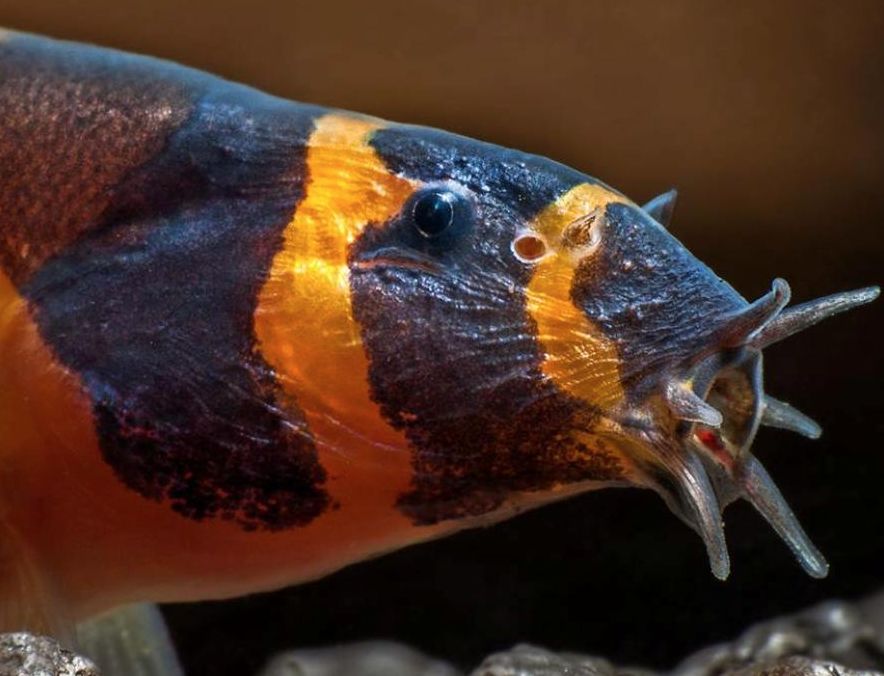
Difficulties in keeping
Caring for kuhli loaches is straightforward, but it requires attention to their specific needs. One of their distinguishing features is the absence of scales, making them particularly sensitive to medications and chemical treatments. This sensitivity should be kept in mind when introducing any substances into their tank.
Kuhli loaches thrive in clean, well-aerated water with regular water changes. It’s important to siphon the bottom during these changes to remove detritus, as these ground-dwelling fish are especially susceptible to ammonia and nitrate buildup.
Being primarily nocturnal, kuhli loaches exhibit most of their activity during twilight and nighttime, often hiding during the day. While they can be elusive, observing them becomes easier with patience, especially if you have multiple loaches in the tank, as their activity may increase due to competition for food.
Keeping a group of about a dozen kuhli loaches can encourage more natural behavior reminiscent of their wild counterparts. However, they can also thrive as solitary fish in a well-maintained aquarium. These resilient fish can live for many years in captivity, often showing no adverse effects from being alone, provided their environmental needs are met. Their ability to breathe through their intestines allows them to survive in low-oxygen conditions, a trait that is beneficial in their natural habitat.
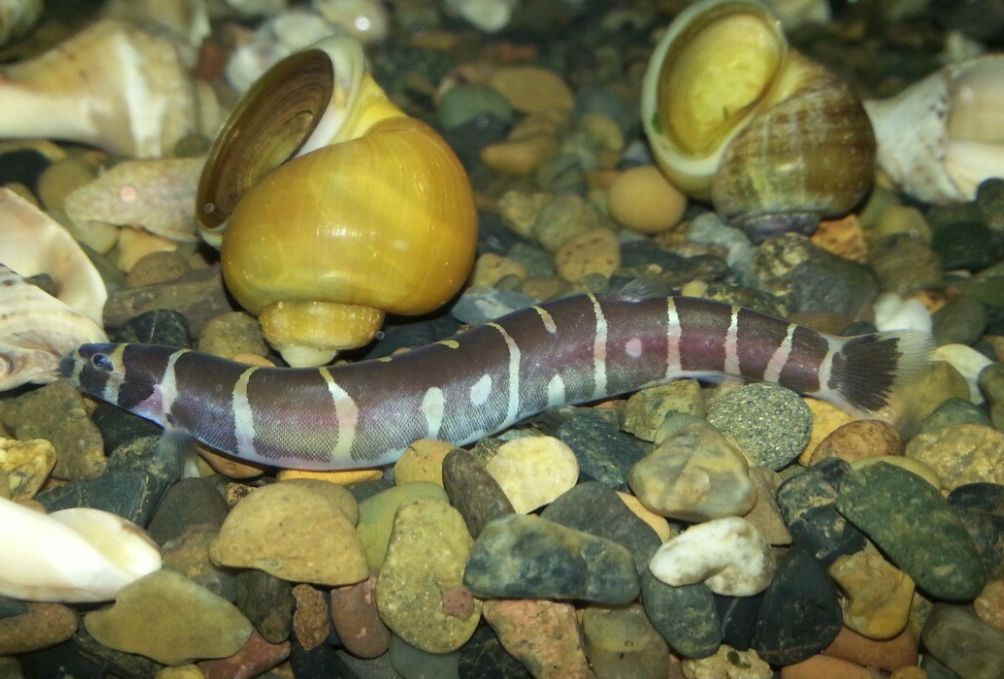
Care and keeping in a tank
Tank size
The tank size for kuhli loaches is crucial for their well-being and largely depends on the number of loaches you plan to keep and their tank mates. These social fish thrive best when housed in groups of five or more. As bottom-dwellers, they require ample space to explore, scavenge, and feel secure.
For a small group of kuhli loaches (5 to 6 individuals), a minimum tank size of 20 gallons (approximately 75 liters) is recommended. This size allows them enough room to roam and interact comfortably. Since they are ground fish, the tank’s bottom area is more important than just the overall volume; providing a spacious substrate is essential.
If you intend to keep a larger group of kuhli loaches or include other fish species in the tank, consider increasing the tank size accordingly. A larger aquarium not only offers more swimming and hiding spaces but also helps maintain better water quality in a community setting.
Remember that while kuhli loaches are small, they are quite active, especially at night.
Lighting
The tank environment for kuhli loaches should be moderately sized, featuring soft, slightly acidic water with moderate lighting. Since these fish are nocturnal, bright tank lighting is not ideal; they feel more comfortable in scattered, dim light that mimics their natural habitat.
Water parameters
Here are the key water conditions to consider:
Temperature: Kuhli loaches prefer warm water, with an ideal temperature range of 24°C to 30°C (75°F to 86°F). It’s crucial to keep the temperature stable, avoiding rapid fluctuations that could stress the fish.
pH Level: These loaches thrive in slightly acidic to neutral conditions, with a recommended pH range of 6.0 to 7.5. Regular testing will help ensure these levels are maintained.
Water Hardness: They prefer soft to moderately hard water, ideally within a hardness range of 2 to 12 dKH. Using water conditioners or specific substrates can help achieve this.
Ammonia and Nitrite: Both ammonia and nitrite are toxic to fish, so it’s essential to maintain undetectable levels in the tank. Regular water testing and effective filtration are necessary to achieve this.
Nitrate: Nitrate, a byproduct of the nitrogen cycle, should be kept at low levels. While less toxic than ammonia and nitrite, high nitrate concentrations can still be harmful. Aim to keep nitrate levels below 40 ppm.
Water Movement: Kuhli loaches prefer slow-moving or still waters, making it best to avoid strong currents in the aquarium. This can be achieved by using gentle filtration systems or strategically placing decorations to break the flow.
Filtration
Proper filtration and regular water changes are essential for maintaining a healthy environment for kuhli loaches. A reliable filtration system helps keep the water clean and clear by removing toxins and waste.
It’s recommended to perform weekly water changes of 25-30% of the total tank volume to maintain water quality. When siphoning the substrate, be cautious to ensure that the loaches aren’t accidentally sucked into the water flow. These fish are skilled at hiding in unexpected places, so take your time and monitor the process to avoid any mishaps.
Tank setup: decorations and plants
To create a suitable habitat for kuhli loaches, it’s essential to incorporate various shelters in the tank, such as snags, caverns, and ceramic tubes or coconut shells with small openings. These structures provide hiding spots where the fish can retreat during the day, as kuhli loaches are quite timid and tend to hide quickly among thick plants or rocks when startled.
A densely planted tank is ideal since kuhli loaches enjoy spending their daytime in vegetation. The substrate is particularly important; it should consist of fine, smooth grains—sand is the best choice because it allows the fish to burrow and search for food like bloodworms. Fine gravel can also work if it is smooth and rounded, but coarse or sharp substrates can injure the fish. In contrast, gravel that is too large or jagged limits their digging behavior.
Since kuhli loaches are bottom dwellers, ensure that any stones in the tank are smooth to prevent damage to their delicate skin. It’s also crucial to cover the filter’s input and output with grating that has small holes, preventing the fish from entering. Be mindful of any gaps or slits in the filter system where a curious kuhli loach might get trapped. While they primarily inhabit the tank bottom, covering the top of the tank is recommended to prevent escapes through even the tiniest openings.
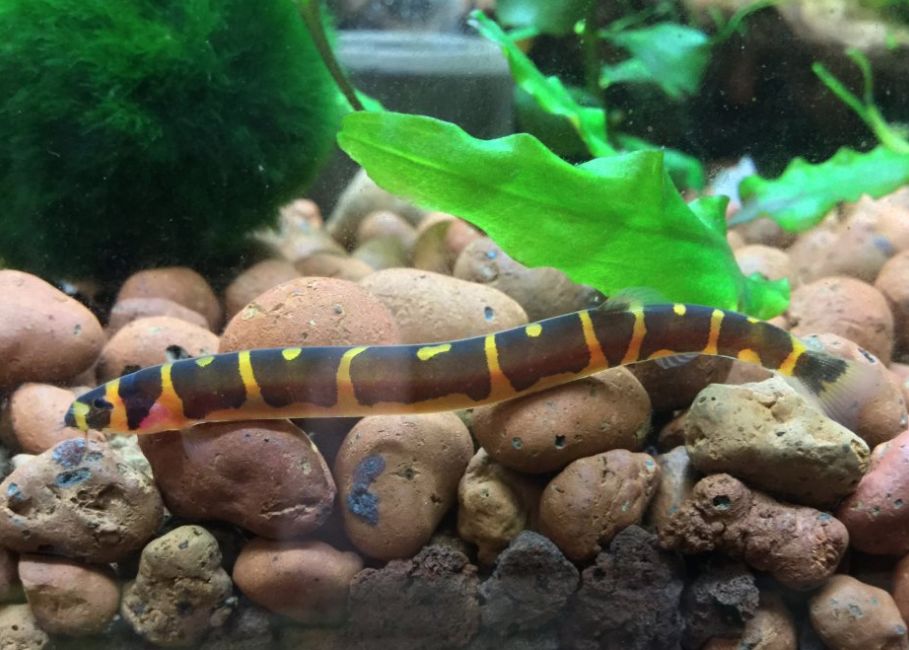
Diet
Kuhli loaches are fascinating scavengers commonly found in aquariums, known for their unique feeding habits. In the wild, they consume a variety of small invertebrates, insect larvae, detritus, and microorganisms located in the substrate and among plants. As euryphagous fish, they thrive on various food types, including live and frozen options, along with sinking tablets, granules, and pellets. It’s essential that the food is positioned at the bottom of the tank, as kuhli loaches prefer to forage there, especially when the lights are dimmed.
To maintain a balanced diet, consider the following feeding options:
Live Foods: Kuhli loaches enjoy live foods such as bloodworms, tubifex, brine shrimp, and daphnia. They excel at foraging in the substrate for hidden morsels, making them valuable contributors in tanks with other fish that may drop live food. However, caution is advised when introducing live foods, as they can carry diseases or parasites.
Frozen or Freeze-Dried Foods: A safer alternative to live food, frozen or freeze-dried options like tubifex worms, daphnia, and brine shrimp are excellent choices that provide nutrition without the associated risks.
Vegetables: Incorporating vegetables into their diet is crucial, accounting for about 20% of their intake. Foods rich in spirulina, especially sinking pellets, are recommended, as they provide sustained availability for loaches to graze on.
Snails: Occasionally, kuhli loaches may feed on snails. They typically approach the snail, insert their head into the shell, and use a tapping motion against the substrate to break it open.
Commercial Fish Food: High-quality sinking pellets or granules designed for bottom-dwelling fish serve as a reliable staple. Look for formulations containing a balanced mix of animal and plant proteins to cater to their omnivorous diet.
Tank mates
Kuhli loaches may not exhibit traditional schooling behavior, but they thrive in groups of four to five or more, feeling more secure in numbers. When kept in smaller groups, such as one or two, they tend to be more reclusive, emerging from their hiding spots primarily at night. These fish are completely peaceful and compatible with others of similar size, scavenging for leftovers that other fish leave behind on the tank bottom.
In a community tank, kuhli loaches can coexist harmoniously with small, gentle tank mates that inhabit the middle and upper water layers. Ideal companions include species like tetras, rasboras, and peaceful barbs, which contribute to a lively and balanced aquarium environment.
- Harlequin Rasboras (Trigonostigma heteromorpha)
- Neon Tetras (Paracheirodon innesi)
- Ember Tetras (Hyphessobrycon amandae)
- Glowlight Tetras (Hemigrammus erythrozonus)
- Black Neon Tetras (Hyphessobrycon herbertaxelrodi)
- Cardinal Tetras (Paracheirodon axelrodi)
- Rummy Nose Tetras (Hemigrammus rhodostomus)
- Dwarf Gouramis (Trichogaster lalius or Trichogaster chuna)
- Sparkling Gouramis (Trichopsis pumila)
- Celestial Pearl Danios (Danio margaritatus)
- White Cloud Mountain Minnows (Tanichthys albonubes)
- Dwarf Rasboras (Boraras spp.)
- Endler’s Livebearers (Poecilia wingei)
- Guppies (Poecilia reticulata)
- Platies (Xiphophorus spp.)
- Corydoras Catfish (Corydoras spp. – pygmy cory, panda cory, adolfoi catfish)
- Otocinclus Catfish (Otocinclus spp.)
- Bristlenose Plecos (Ancistrus spp.)
However, some fishes are not recommended to put in one tank with loaches. Kuhli loach should be in one tank with cichlids.
First of all, these are large cichlids (oscar fish, green terror, flowerhorn, red terror cichlid). These predators will treat loaches as food. Goldfishes mostly are bottom diggers, and they’ll disturb loaches; besides, they require essentially lower tank water temperature. Territory-dependent bottom-dwelling fish such as red-tailed black sharks also aren’t the best tank mates for loaches, and they may harm them.
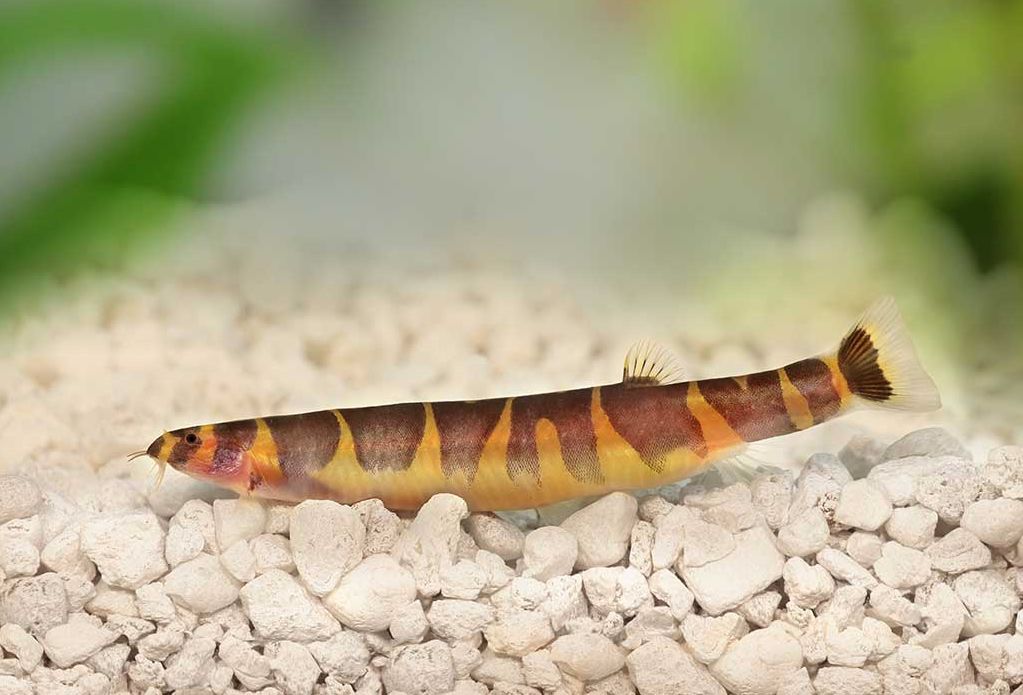
Gender differences: male vs female
Identifying the gender of kuhli loaches can be quite challenging due to their feeble sexual dimorphism. Unlike many fish species, kuhli loaches lack obvious distinguishing features such as color patterns, fin shapes, or significant size differences. Most often, determining their sex requires careful observation of behavior and physical characteristics over time. Even experienced aquarists may find it difficult to make a definitive identification.
Here are some general observations that may help differentiate between males and females:
Size and Body Shape: Males tend to be slightly smaller and narrower, with smoother abdomens. In contrast, adult females have a more cylindrical body shape, and their abdomens are often rounded, sometimes showing slight swelling near the anus. If a female is carrying eggs, they may appear as elongated greenish spots on her abdomen. However, this size difference can be subtle and not always reliable.
Behavior: Females may exhibit increased robustness and activity during breeding season, particularly when carrying eggs, which can be another clue to their sex.
Vent Position: Males have a thickened, branched first ray of the pectoral fin. Some experienced aquarists suggest that males might have a slightly protruding vent, but this distinction can be difficult to observe, especially in smaller or younger individuals.
Ultimately, accurately sexing kuhli loaches may not be essential for their care in a home aquarium. As long as their environmental needs are met, these fish will thrive regardless of gender identification.
Breeding
Breeding kuhli loaches in an aquarium can be a rewarding yet challenging endeavor, as these fish do not typically breed easily in home settings. Successful breeding occurrences are relatively rare. Even under optimal conditions, kuhli loaches may spawn in a community tank, but their eggs often go unfertilized and are quickly consumed by the parents or other fish. However, with proper care and attention, it is possible to encourage breeding behavior.
In the wild, kuhli loaches usually spawn during December and January. To stimulate spawning in an aquarium, replicating the rainy season can be effective, ideally combining this with a change in atmospheric pressure. You should aim to soften the tank water, decrease the temperature, and reduce lighting intensity and duration, though the effectiveness of each factor may vary.
For successful breeding, consider using hormonal injections of gonadotrophin, which can initiate spawning within 6 to 8 hours. A breeding tank with a capacity of at least 30 liters (water height of 15-20 cm) is recommended, equipped with a separation net to protect the eggs.
The ideal ratio for breeding is two males to one female, with the female exhibiting a noticeably rounded abdomen. During the courtship, the male pursues the female, gently pressing his head against hers, resembling a tender embrace.
Once spawning occurs, the couple will move swiftly along the tank bottom and ascend to the water’s surface, where the female releases approximately 500 to 700 small light green eggs. These eggs will adhere to plants or settle on the tank bottom. It is crucial to remove the parent fish shortly after spawning to prevent them from eating the eggs.
The incubation period for the eggs lasts about one day, after which the tiny green fry will hatch. Within four days, they begin swimming and foraging. Newly hatched loach fry can be fed infusorians, rotifers, brine shrimp nauplii, or finely chopped tubifex. In about a month, the fry will reach approximately 1 cm in length and start to develop their distinctive stripes. They typically become reproductive at around 8 to 12 months of age.